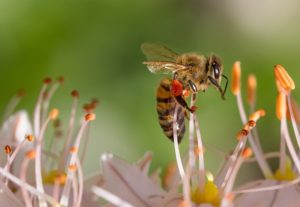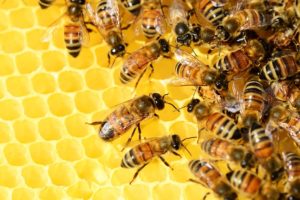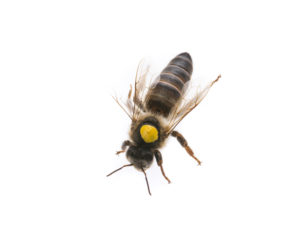Why Do Bees Swarm?
We’ve all seen those iconic scenes where a swarm of angry bees chases a person down. But why do bees swarm? As it turns out, the answer is both more simple, and more complex than you might imagine. Many people have the impression that bees swarm to protect their hive. In fact, defending their hive is an entirely different process, and it’s not swarming.
What is Swarming?
Before we get into why exactly bees swarm, we need to go over what swarming actually is. There are certain times of year bees are more likely to swarm, because bees don’t like flying in poor weather. Just like queens rely on good weather to successfully mate, the colony relies on good weather to enable a swarm.
What is swarming?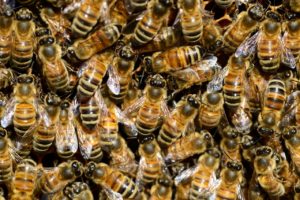
It’s when the colony, as a mass, leaves the hive. For the most part, either the entire colony leaves the hive, or a good portion of it does. In short, swarming is an exodus from the beehive.
Why do Bees Swarm?
Now that we know swarming is just when bees leave their hive (en masse, of course), we can get into the reasons for why they leave. There are a couple main reasons they swarm: relocating for resource based reasons, and overcrowding within the hive.
 Population management
Population management
If a hive is doing well, has a prolific queen, and resources to sustain a certain population, it can become overcrowded. When there are too many bees, these once abundant resources quickly become scarce. If this continues, the bees inevitably run out of resources. Then, there’s no way the colony can survive.
To keep the colony from going above the hive’s capacity, and conserve crucial resources, a portion of the hive population leaves in a swarm. They then go to find another suitable hive location where they can essentially create a new colony. In short, it’s a method for bees to create a subdivision of their hive for the benefit of them all. 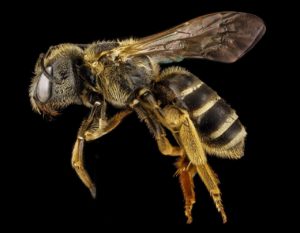
Typically, around half of the bees leave the original hive to move to another location. When this happens, the old queen usually also goes with them. This means the remaining half of the bees are left to raise a new queen to continue the original hive. However, the half of the hive that leaves will rarely do so until there’s a suitable new queen to take over.
Resource shortages
Whether it’s due to population or to find a better location, swarming is mostly about resources. Even when a hive isn’t becoming overpopulated, there can still be problems with local resources. There might not be enough water, nectar, and pollen for bees to produce the food (and honey) they need to survive. When this happens, the bees know it’s time to move on so they can gather enough resources to last them through the winter.
If bees swarm to a new location because of a lack of resources, the entire hive moves, rather than just a portion of it. That means that they don’t need to rear a new queen. As long as the queen is producing enough of the pheromones that tell the worker bees that she’s still healthy, and laying enough eggs, she goes with the rest of the colony.
Bees are more likely to swarm in the spring, especially if they’re relocating because of a lack of resources. This allows them the time they need to rebuild a hive, rear brood, and gather the resources they need to overwinter.
Related- other reasons bees swarm:
- Disturbances around the hive
- Parasites and disease
- Climate related reasons
- Issues with the current queen
- Insufficient ventilation
How Swarming Works
We know that bees swarm not to attack, but rather to relocate. While this is typically because either the current hive is reaching capacity, or because the location of the current hive lacks sufficient resources, there are other reasons. However, another important thing you should understand is exactly how swarming works. It’s not a spur of the moment decision, and the bees have plenty of preparation to do before they can swarm, no matter the reason.
Bees are eusocial, meaning they’re social animals, and work as a group to allow the colony to survive. Without each bee doing their job, the colony as a whole won’t survive.
If the colony divides, and leaves some of the bees in the original colony, they need to prepare a new queen. This is because the original queen will leave with the swarm, and without a new queen, the original colony can’t continue.
To allow this to happen, the worker bees find appropriate female larvae to begin raising as a potential new queen. The main determining factor in whether female larvae develop into a worker bee, or potential new queen, is their diet. Each larvae gets a small amount of royal jelly, but worker bees primarily get ‘brood food.’ Potential queens on the other hand, are fed royal jelly exclusively. Bees will raise multiple larvae as potential queens, and let the virgin queens battle for supremacy.
Whether or not the bees need to start rearing a potential new queen, the next steps of the swarming process are pretty much the same.
The queen is certainly heavier than your average worker bee, which also makes it more difficult for her to fly. To make it easier, the workers prepare her to fly with the swarm by feeding her less food. This helps slim her down before they take flight.
If the hive doesn’t need a new queen, they’ll actively try to prevent the current queen from laying any new eggs. The worker bees essentially fly around the queen, move her away from laying eggs in brood cells, and generally disrupt her routine. If they do need a new queen, worker bees construct special queen cells to allow the current queen to lay eggs they can raise into larvae to raise as a queen.
Once it’s time to swarm, the worker bees leave the hive en masse, taking the queen with them. However, they’re not ready to move into a new location yet. The bees allow their queen to rest, while scout bees search out a suitable location to create their new hive. While the scouts find a good location, the other bees crowd around the queen to protect her, and help regulate her temperature as needed.
How long does scouting for a swarm take? It depends on the resources and locations available, as well as the weather. It can take many days, or as little as an hour.
Until then, the bees continue caring for their queen bee. Once the scouts do find a suitable location, they return to the rest of the colony, and move to the new location as a group, taking the queen with them.
Upon reaching their new hive location, the bees get right back to work building up the comb and finding a place for the queen to settle into. From there, bees continue their regular duties within the hive, and build more comb to grow the hive itself. Whether it’s rearing the brood, feeding the queen, gathering resources, or defending their new home, all the worker bees get back to their routine.
Frequently Asked Questions
Do swarms attack people?
Despite what you’ve certainly seen depicted in the movies, swarming bees are less aggressive and defensive than those in a hive. Bees typically attack because they’re defending their queen, food, and their brood. Swarming bees have only their queen to worry about. As a result, they really aren’t much of a threat to people, and tend to be far more docile, as long as you leave them alone.
Can you gather swarms to keep bees?
Not every beekeeper chooses this method to gather bees, and for a few reasons. You need enough experience to know how to safely gather the bees (for them, and yourself). Nobody wants to accidentally crush bees. Next, you also need to be sure you can safely gather their queen, or prepare to effectively introduce a new queen (see our article on requeening a hive for more information). Lastly, you have to be very exact in your timing, to a certain extent. If you move too late, and the bees are already creating a new hive, they’ll be much more defensive and guard their new home.
How do beekeepers manage swarms with kept bees?
There are several different techniques beekeepers can use to manage their bees if they begin swarming. One way beekeepers like to make it easier is by choosing breeds that swarm less to begin with. Learn more about the different types of bees for beekeeping in our article. Next, you can manage your hive with regular inspections to determine their level of resources, and their overall population. If a hive starts becoming overcrowded, you can move some of the bees to a new hive, before they swarm and fly off to find a new location for themselves. The best time to do this is in the spring, when bees are more inclined to swarm anyway.
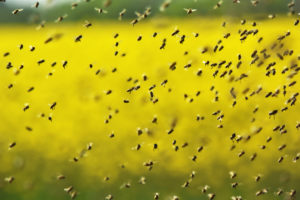 Population management
Population management 